Chile’s part in Shacklteon’s Success
Do you know, it was just one hundred years ago that Ernest Shackleton and his men were down in Antarctica, trying to cross the White Continent?
Well it was. And the centenary of the event is being celebrated not only in Britain but also in Chile, because this country became inadvertently involved in the undertaking.
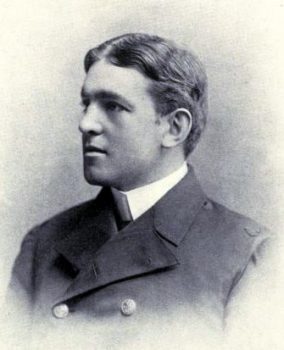
Shackleton’s first adventures in Antarctica were as part of Robert Falcon Scott’s team. Whereas Scott began his career, at the age of just thirteen, as a naval officer, Shackleton came from a family of lesser means and had to work his way aft. He joined a merchant ship at the age of sixteen as an apprentice, but by the time he was 24 he had earned his Master’s ticket and was qualified to captain any British merchant vessel.
In the last years of the 19th century, Scott’s father lost all his money through bad investments and subsequently died of a heart attack. The young man now found himself responsible for supporting his mother and his younger siblings, and according to some historians, it was the need for a well-paying job rather than an interest in Antarctica which led Scott to volunteer as the leader of a proposed expedition to explore and chart this region. By a lucky fluke (or was it an unlucky one?) he happened to be acquainted with the man who was organising the venture – a joint enterprise between the Navy and the Royal Geographical Society – and it was this which secured him the command.
Meanwhile, Shackleton is portrayed by historians as a restless soul who was forever in search of fulfilment. He heard about the polar expedition from a man whose father just happened to be the main financial backer. As the saying is, “It’s not what you know but who.”
This first attempt by the British to reach the South Pole, in 1902, was a failure – and one of the biggest failures was Shackleton. After spending almost a year in Antarctica, surveying the region, Scott, Shackleton, and the expedition’s doctor set out to walk the distance to the Pole, carrying their food on sledges. Unfortunately, the dogs pulling the sledges became ill and died, forcing the party to turn back; and on the return trip Shackleton collapsed and had to ride on the sledge while the other two pulled it.
When their supply ship arrived, Scott sent Shackleton home – but he himself remained in the South for a further two years, exploring the continent, collecting rocks and fossils, and undertaking scientific experiments. On their return, Scott and his men were greeted as heroes. Perhaps that is the reason why he felt the urge to return and achieve even more; and certainly it is why Ernest Shackleton couldn’t leave the place alone.
Back in England, Shackleton tried and failed to get a job as a naval officer; he had a shot at journalism; and he failed to get himself elected to parliament. He also made a proposal of marriage, and in this he was much more successful. He started a family. But throughout all of these undertakings he retained his desire to go South again. Eventually, he managed to cultivate the appropriate friendships and arouse sufficient interest to gain the necessary financial backing, and in 1908 he returned to Antarctica and had another go at the Pole. On this occasion, Shackleton and two companions managed to get themselves within 120 miles of their destination – which was further south than anyone had managed before – and thus, when he returned, he was lauded as a hero. The king even gave him a knighthood.
Ah, this fame and glory stuff…! Seemingly, it goes to the head.
Shackleton, the common man, was now Sir Ernest, whereas Scott, on his return a few years before, had only won a lesser gong. It was time for him to pick up the gauntlet. In 1910 he was dispatched on an expedition which the Royal Geographic society hoped would be “primarily scientific, with the Pole as a secondary objective”; but they weren’t in command. Scott’s openly avowed aim was to be the first man at the Pole and thereby to achieve glory for the British empire.
Rule Britannia; Land of Hope and Glory; and all that. Rousing stuff, no doubt – but dangerous, too.
Scott was just embarking when he learned that the Norwegian explorer, Roald Amundsen, was also heading for the Pole. This obviously must have put the pressure on him. Coming from a land of snow and ice, Amundsen had a lot more experience than the Briton of the sort of conditions prevailing in Antarctica.
Amundsen had decided to use dogs for his expedition whereas Scott, in the light of his previous misadventure, had chosen to bring ponies. Various people warned him against the idea – and in the end the ponies all died, and he and his men were once again obliged to haul their sledges over the uneven ice using their own muscles.
Incredibly, Scott got to the Pole – but, as everyone knows, Amundsen had already been there. Arriving in February 1912, he beat the British team by just five weeks. In his diary, Scott wrote, “The worst has happened. … God, this is an awful place!”
Scott didn’t make it home. But there’s nothing quite like a dead hero for arousing national pride. Indeed, his own words pretty much invited and incited such a reaction. In a letter addressed to the public he wrote:
“We took risks, we knew we took them; things have come out against us, and therefore we have no cause for complaint, but bow to the will of Providence, determined still to do our best to the last… Had we lived, I should have had a tale to tell of the hardihood, endurance, and courage of my companions which would have stirred the heart of every Englishman. These rough notes and our dead bodies must tell the tale, but surely, surely, a great rich country like ours will see that those who are dependent on us are properly provided for.”
Stirring stuff.
Scott was posthumously awarded the coveted knighthood, poems were written in his honour, and memorials sprouted all over the country.
But what of Shackleton? The Pole had been won, and his rival had managed to steal the limelight. There remained only one exciting option open to Shackleton, and he now proposed it: He would walk right across the white continent.
In August of 1914 – and despite the outbreak of World War II – Shackleton’s two ships were given permission to proceed to sea and head south. The first ship, Endurance. was to drop off the party of explorers, and the other, the Aurora, would sail round to the other side of Antarctica and pick them up. That was the plan.
Unfortunately, before she could get to the drop off point, the Endurance became trapped in the ice. She subsequently sank, leaving the boss, his team of twenty-seven men, one cat, and seventy dogs all stranded. Needless to say, things did not go well for the dogs… And the cat was summarily shot, for no particularly good reason.
After two months drifting on the ice, Shackleton decided to take his troops to Elephant Island. Before their ship sank they had unloaded all of the stores and had also taken off the boats. Having spent weeks hauling these over the ice, they then spent five wet and miserable days rowing through the floes to attain their objective. They were now on solid land. However, their chances of surviving the winter without sufficient provisions and better shelter were not good, and thus the commander resolved to go and get help.
Having derided the quest for celebrity status, I have to say that the heroes of this Glorious Age certainly lived up to the standards expected of them. Twelve years earlier, Shackleton had been nothing more than an upstart whose ill-health caused him to fail in his duty; but now he was a knight of the British empire. Now came the moment when he could show the world that he was just as great as that other chap whose body lay amongst the snows to the south. Scott had demonstrated that success was not the main thing. The main thing was valour. Shackleton didn’t have to pretend; he had as much valour as any hero in shining armour and – more important still – he also had the determination of Staffordshire terrier. When he’d got his teeth into something, he would not let go. Not ever.
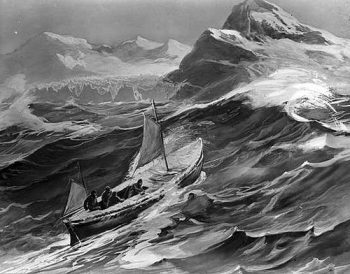 The story of Shackleton’s voyage across the stormy ocean to South Georgia is well-known. After fifteen days the men reached their destination, landing on the island’s bleak and uninhabited southern shore. From here the indefatigable explorer led three of his team over the mountains to the Norweigan whaling station of Stromness – an endeavour which some say is even more incredible than the journey across the southern ocean in an open boat. Afterwards, Shackleton wrote, “I have no doubt that Providence guided us…I know that during that long and racking march of thirty-six hours over the unnamed mountains and glaciers it seemed to me often that we were four, not three.”
The story of Shackleton’s voyage across the stormy ocean to South Georgia is well-known. After fifteen days the men reached their destination, landing on the island’s bleak and uninhabited southern shore. From here the indefatigable explorer led three of his team over the mountains to the Norweigan whaling station of Stromness – an endeavour which some say is even more incredible than the journey across the southern ocean in an open boat. Afterwards, Shackleton wrote, “I have no doubt that Providence guided us…I know that during that long and racking march of thirty-six hours over the unnamed mountains and glaciers it seemed to me often that we were four, not three.”
Again, it was good stuff – but the epic journey would count for little if the rest of the ship’s company could not be saved. Indeed, for the commander to get away with his life while his men perished might even be described as “a jolly poor show”.
The Norwegian whalers immediately sent a motor-boat to rescue the men who had been left on the far side of the island, and they also salvaged the little boat. Meanwhile, Shackleton was already applying himself to the business of finding a suitable vessel with which to return to Antarctica. He must surely have felt that his luck was in when the owners of the whaler, Southern Sky, agreed to let him charter her; and just two days after arriving in the whaling station, having assembled a crew of volunteers, he was underway.
Alas, when the whaling ship reached the vicinity of Elephant Island, Shackleton found that the place was now thronged with pack ice which extended for 70 miles. The vessel was not equipped to bash her way through, and so they had to turn round. There was no point in going back to South Georgia, and so Shackleton headed for the Falkland Islands.
By now it was late May. The temperature would be well below zero all day and night, and the ice would be getting thicker every day. The chances of any vessel being able to get through to Antarctica during the next six months were slender, to say the least – but Shackleton had the bone in his teeth. On reaching the Falklands he cabled London and asked the Admiralty to send a ship. They informed him that it would be with him in October… and so he approached the British Commission in Uruguay. The Uruguayans sent a trawler to rescue the shipwrecked mariners; but, again, it was thwarted by the pack ice.
Shackleton had told his men that he expected to be back in a month’s time. As the days passed and became weeks he must have become increasingly worried – but he still didn’t give up. From the Falklands he travelled to Punta Arenas, in the Magellan Straits. Here he met the owner of a 70 ton sealing schooner called Emma. Having chartered the boat and provisioned her, with the financial support of the British Club, on the 12th July he set out again. And he got the same result.
By now the men had been abandoned on the ice for three months. It was mid-winter. It was perfectly obvious that no one and nothing was going to be able to get through to them before Spring. But Shackleton just kept on banging his head on the wall.
Well, what other choice did he have?
If he could, he would have swum down to Antarctica to rescue his men.
The Emma had been towed out to sea by a steam-tug called Yelcho. Built in Scotland in 1904, this vessel belonged to the Chilean navy; and when Shackleton now turned to the Chileans for help, it was the Yelcho which was offered to him.
At 120ft (37m) the Yelcho was small for the task of breaking her way through the ice. Moreover, like the Norweigan whaling ship, the Uruguayan trawler, and the British sealer – and unlike ships designed for bashing about in the ice – she had only had a single skin. However, the fact that she was built of steel certainly counted for something.
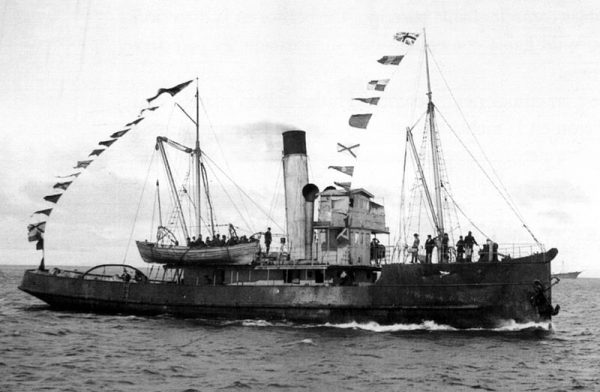
Compared to a modern Antarctic-going Research Vessel the Yelcho seems wholly inadequate for the job in hand, but compared to a small modern yacht she has a lot going for her; and compared to an open whaling boat… she must have seemed deluxe.
In any event, she was the only thing available, so Shackleton grabbed her with both hands.
The three previous attempts to get South again had been made under the command of Worsley, the skipper of the ship which had sunk in the ice. On this occasion, however, the vessel came complete with naval officer and crew.
The man who captained the Yelcho was called Luis Pardo. He and Shackleton were both Freemasons, although Shackleton didn’t realise this till afterwards (so perhaps all that stuff about the funny handshakes is fiction). The other thing that the two men had in common was membership of the stout-hearted club. This is what Pardo had to say to his father in a letter which he left behind:
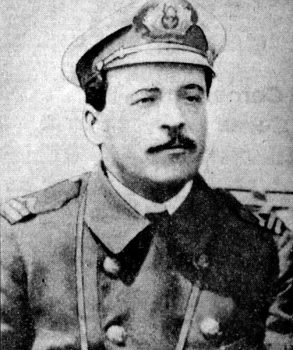
“The task is great, but nothing scares me: I’m a Chilean. Two considerations make me face these dangers: to save the explorers, and to add glory to my country. I would be happy if I could achieve what others have failed to do. If I fail and die, you will take care of my Laura and my children who would be left without support except yours. If I succeed, I shall have fulfilled my humanitarian duty as a seaman and a Chilean. When you read this letter, either your son has died or he has arrived at Punta Arenas with the castaways. I shall not return alone…”
What was it about the late 19th and early 20th century…? What made these men so jolly nationalistic, wonder?
And was it this heart-swelling pride in the powers and righteousness of one’s own splendid nation which led to war – and not just once, but twice?
I rather think that it was. As I say, this No Guts, No Glory stuff strikes me as being rather dangerous.
But, then again, if Shackleton and his brother, Pardo, had not been so proud and true and so thoroughly nationalistic, there would now be twenty-two memorials on Elephant Island and twenty-two bodies buried under the snow.
As it was, Luis Pardo managed to find a way through the ice, and on 30th August 1916 the little ship arrived off Elephant Island. Not one man of those whom Shackleton had left behind had perished. They were all taken off, and the Yelcho returned to Punta Arenas to a rapturous welcome. From that port, the tugboat took her cargo of heroic explorers north to Valaparaiso, and here, it is said, 30,000 people came to the seaside to greet them.
One seldom hears report of Shackleton’s other ship, which had been sent to the other side of the continent. On reading accounts of the expedition one finds that the Aurora and her men had also fared rather badly. The ship had been carried away in a storm and had ended up trapped in the ice. There she remained, drifting on the ocean, for nine months. In the meantime, a number of her compliment were stranded on the ice.
Having broken free, the Aurora went to New Zealand and, eventually – after sufficient funds had been raised – an operation was mounted to return to the place where the shore-party had been abandoned. Shackleton went with the rescue party, and so learnt at first-hand of the loss of three of the men.
By the time Shackleton and his men got back to Blighty, the war was raging and no one was very interested in the antics of a bunch of dare-devils. People had their own heroes to worry about, and death no longer seemed so glorious.
For me, one of the most amazing things about this whole story is that it took place only one hundred years ago. How our lives have changed since then…!
After the war, Shackleton was still feeling unfulfilled – (they hadn’t let him fight) – and he mounted yet another expedition to Antarctica. He suffered a heart-attack on the way south and then died of another while his vessel was in South Georgia. His doctor had just, only the moment before, told him that he must give up drinking. He was only 47 years old.
Meanwhile – Luis Pardo is said to have been granted a large reward by the British government for his part in the rescue, but is reputed to have turned it down. He said that he was only doing his duty. He was made honorary consul of Liverpool – whatever that means.
The boat in which Shackleton and five of his men crossed the Southern Ocean to South Georgia was shipped to England and is now displayed in the commander’s old school, Dulwich College. By all accounts, Shackleton disliked his time there, but I suppose the school undoubtedly helped to make him what he was.
And as for the Yelcho…
The Yelcho remained in service and, upon the opening of the naval base in Puerto Williams, seems to have been stationed in this southernmost village. In 1958 she was sold by the navy, and in 1962 she was scrapped. Such is the fate of old ships. But in this case, it seems that there are now regrets. When your country is barely 200 years old, every example of heritage becomes precious.
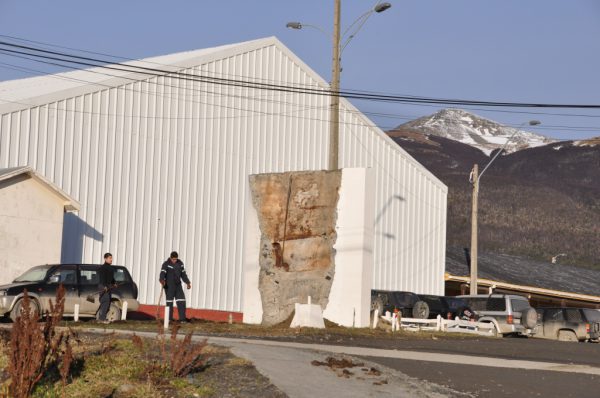
So far as I’m aware, the only parts of the Yelcho still in existence are one anchor – which is outside a yacht club in the Argentinian town of Mar del Plata – and the foremost part of the bow. Until recently, the bow stood on a concrete plinth outside the bank in the one-horse town of Puerto Williams. It wasn’t the most scenic thing in the vicinity. In fact, I never even bothered taking its photograph. But on the day that the navy came and took it away…. you should have heard the fuss!
The bow of the Yelcho has now been carried off to Punta Arenas – an event which seemed to me so insignificant that I didn’t even get a photo of that, either – but the hoo-ha was such that the navy have had to bring it back again.
Or have they…?
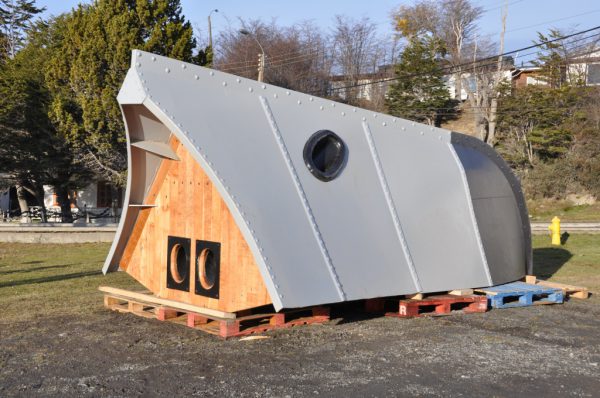
No, they haven’t. They’ve concocted a replica, would you believe?
So – now the town of Puerto Williams will be able to celebrate the centenary of the rescue of Shackleton’s crew with a shiny new replica of part of the bow of the tugboat which did the deed.

Marvelous article, as usual. Bravo Chile! I love Luis Pardo turning down the financial reward but agreeing to be Honorary Consul to Liverpool!